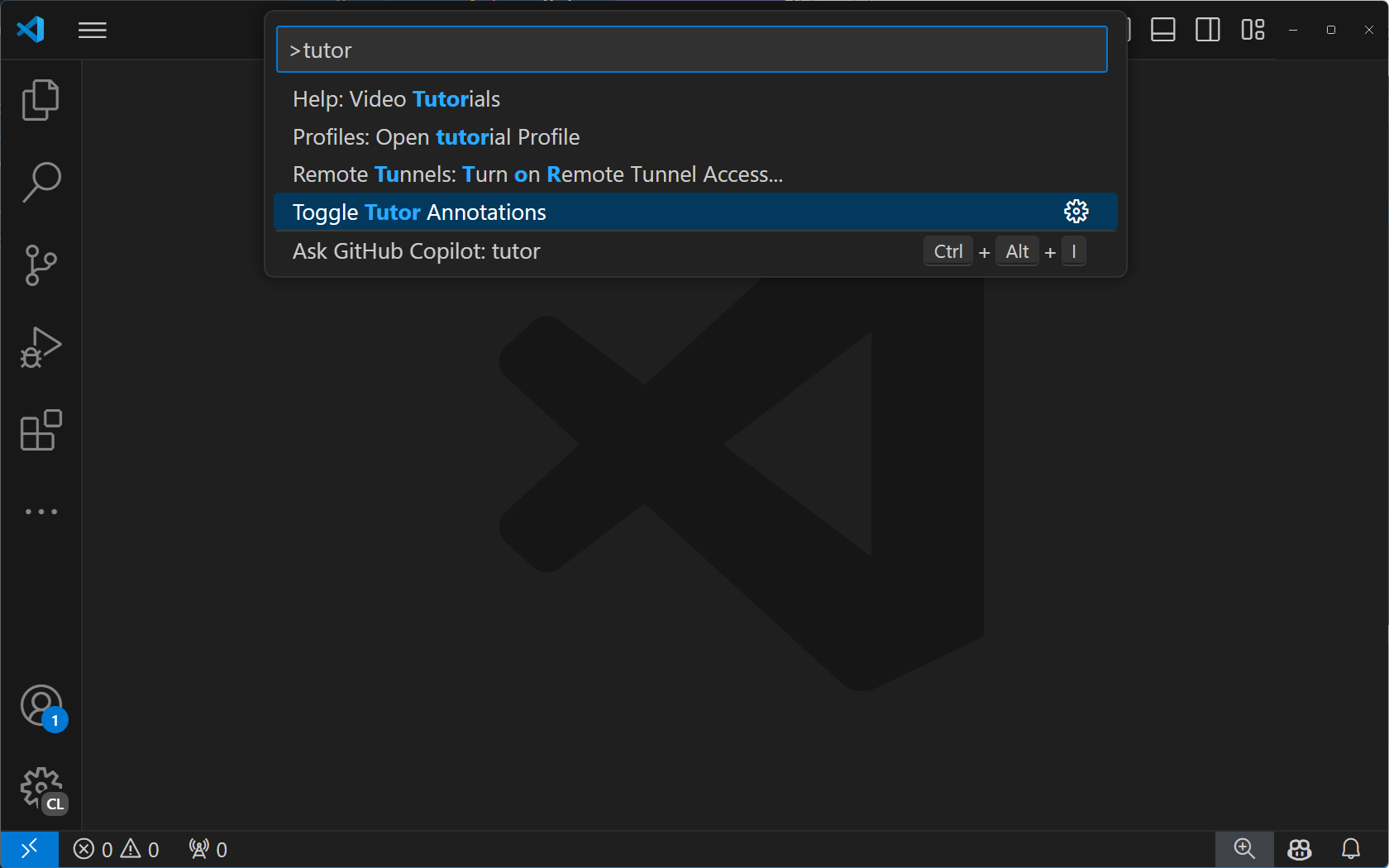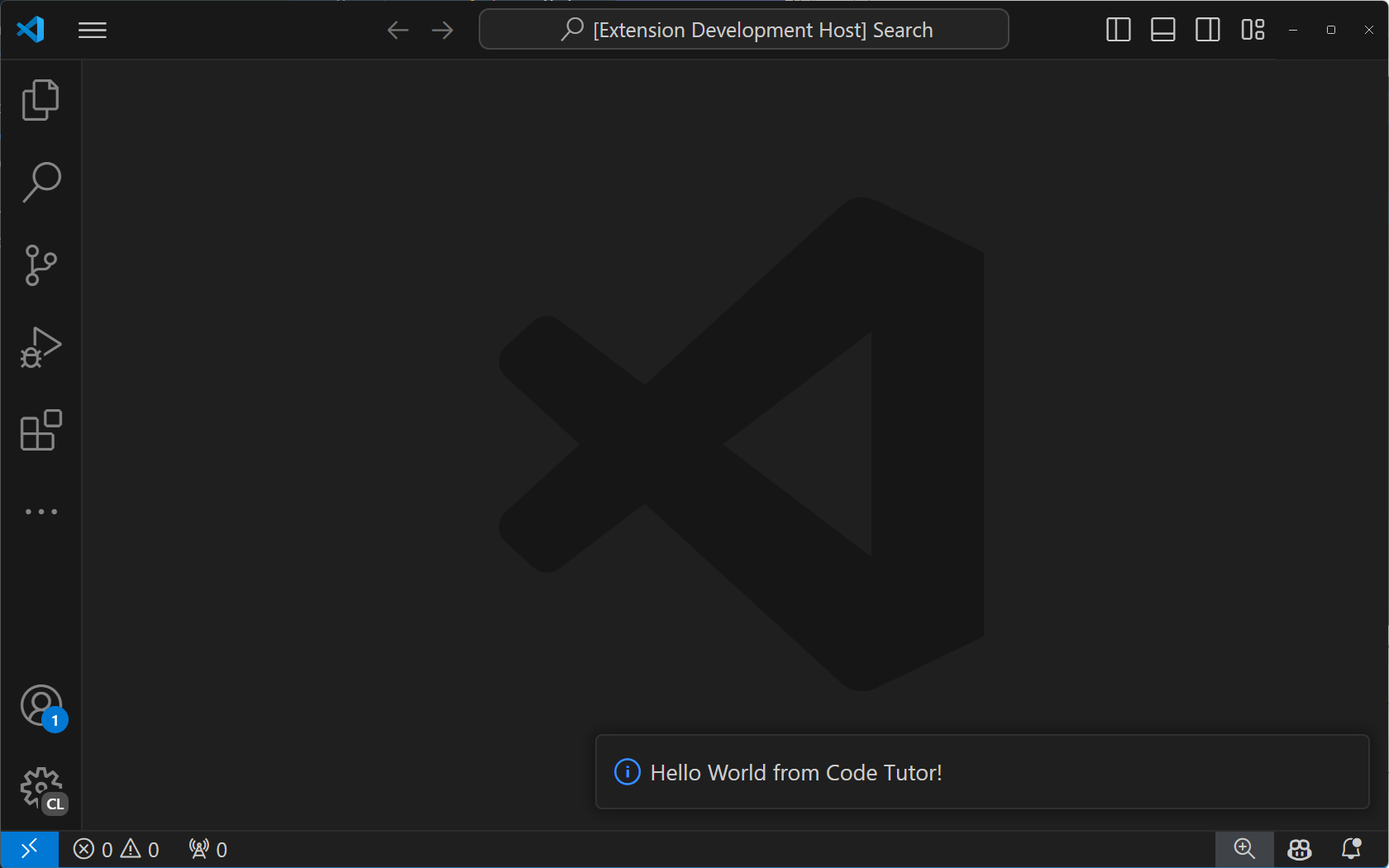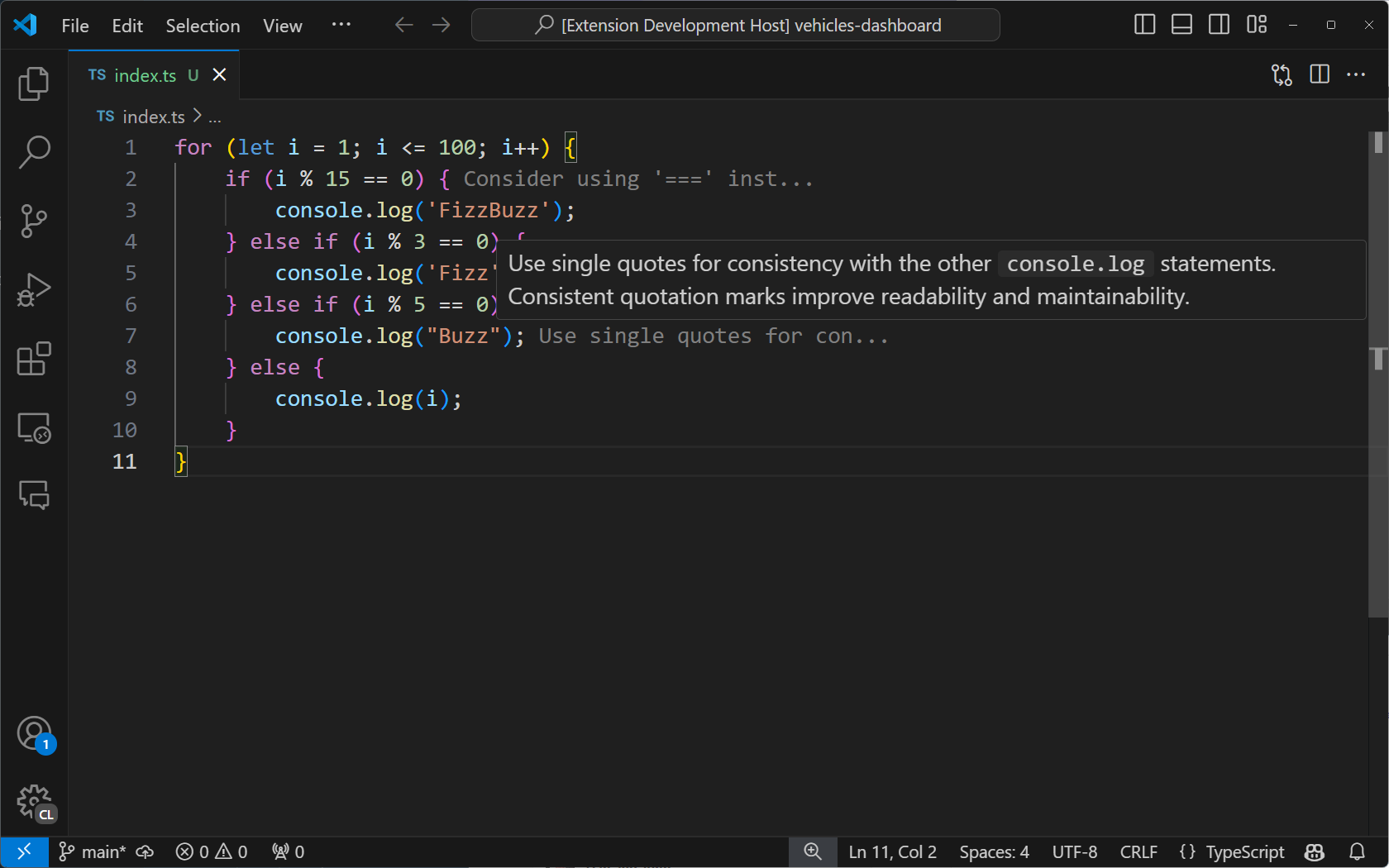教程:使用語言模型 API 生成 AI 驅動的程式碼註釋
在本教程中,您將學習如何建立 VS Code 擴充套件以構建一個由 AI 驅動的程式碼輔導工具。您將使用語言模型 (LM) API 生成改進程式碼的建議,並利用 VS Code 擴充套件 API 將其無縫整合到編輯器中,作為使用者可懸停以獲取更多資訊的內聯註釋。完成本教程後,您將知道如何在 VS Code 中實現自定義 AI 功能。

先決條件
您需要以下工具和帳戶才能完成本教程
搭建擴充套件框架
首先,使用 Yeoman 和 VS Code 擴充套件生成器搭建 TypeScript 或 JavaScript 專案框架,以準備進行開發。
npx --package yo --package generator-code -- yo code
選擇以下選項完成新擴充套件嚮導...
# ? What type of extension do you want to create? New Extension (TypeScript)
# ? What's the name of your extension? Code Tutor
### Press <Enter> to choose default for all options below ###
# ? What's the identifier of your extension? code-tutor
# ? What's the description of your extension? LEAVE BLANK
# ? Initialize a git repository? Yes
# ? Bundle the source code with webpack? No
# ? Which package manager to use? npm
# ? Do you want to open the new folder with Visual Studio Code? Open with `code`
修改 package.json 檔案以包含正確的命令
搭建的專案在 package.json 檔案中包含一個“helloWorld”命令。這是當您的擴充套件安裝後,在命令面板中顯示的內容。
"contributes": {
"commands": [
{
"command": "code-tutor.helloWorld",
"title": "Hello World"
}
]
}
由於我們正在構建一個將在行中添加註釋的程式碼輔導擴充套件,因此我們需要一個命令來允許使用者開啟和關閉這些註釋。更新 command 和 title 屬性
"contributes": {
"commands": [
{
"command": "code-tutor.annotate",
"title": "Toggle Tutor Annotations"
}
]
}
雖然 package.json 定義了擴充套件的命令和 UI 元素,但 src/extension.ts 檔案是您放置那些命令應執行的程式碼的地方。
開啟 src/extension.ts 檔案並更改 registerCommand 方法,使其與 package.json 檔案中的 command 屬性匹配。
const disposable = vscode.commands.registerCommand('code-tutor.annotate', () => {
按 F5 執行擴充套件。這將開啟一個安裝了擴充套件的新 VS Code 例項。按 ⇧⌘P(Windows、Linux Ctrl+Shift+P)開啟命令面板,然後搜尋“tutor”。您應該會看到“Tutor Annotations”命令。

如果您選擇“Tutor Annotations”命令,您將看到一條“Hello World”通知訊息。

實現“annotate”命令
為了使我們的程式碼輔導註釋生效,我們需要向它傳送一些程式碼並要求它提供註釋。我們將分三步完成此操作
- 從使用者當前開啟的選項卡中獲取帶有行號的程式碼。
- 將該程式碼傳送到語言模型 API,並附帶一個自定義提示,指示模型如何提供註釋。
- 解析註釋並在編輯器中顯示它們。
第 1 步:獲取帶行號的程式碼
要從當前選項卡中獲取程式碼,我們需要一個指向使用者開啟的選項卡的引用。我們可以透過將 registerCommand 方法修改為 registerTextEditorCommand 來實現。這兩個命令的區別在於後者為我們提供了一個指向使用者開啟的選項卡的引用,稱為 TextEditor。
const disposable = vscode.commands.registerTextEditorCommand('code-tutor.annotate', async (textEditor: vscode.TextEditor) => {
現在我們可以使用 textEditor 引用來獲取“可檢視編輯器空間”中的所有程式碼。這是螢幕上可以看到的程式碼 - 不包括可檢視編輯器空間上方或下方的程式碼。
將以下方法直接新增到 extension.ts 檔案底部 export function deactivate() { } 行的上方。
function getVisibleCodeWithLineNumbers(textEditor: vscode.TextEditor) {
// get the position of the first and last visible lines
let currentLine = textEditor.visibleRanges[0].start.line;
const endLine = textEditor.visibleRanges[0].end.line;
let code = '';
// get the text from the line at the current position.
// The line number is 0-based, so we add 1 to it to make it 1-based.
while (currentLine < endLine) {
code += `${currentLine + 1}: ${textEditor.document.lineAt(currentLine).text} \n`;
// move to the next line position
currentLine++;
}
return code;
}
此程式碼使用 TextEditor 的 visibleRanges 屬性來獲取編輯器中當前可見行的位置。然後它從第一行位置開始,移動到最後一行位置,將每一行程式碼連同行號一起新增到字串中。最後,它返回包含所有帶行號的可檢視程式碼的字串。
現在我們可以從 code-tutor.annotate 命令呼叫此方法。修改命令的實現,使其看起來像這樣
const disposable = vscode.commands.registerTextEditorCommand(
'code-tutor.annotate',
async (textEditor: vscode.TextEditor) => {
// Get the code with line numbers from the current editor
const codeWithLineNumbers = getVisibleCodeWithLineNumbers(textEditor);
}
);
第 2 步:將程式碼和提示傳送到語言模型 API
下一步是呼叫 GitHub Copilot 語言模型,並向其傳送使用者程式碼以及建立註釋的指令。
為此,我們首先需要指定我們要使用的聊天模型。我們在此處選擇 4o,因為它是一個快速且功能強大的模型,適用於我們正在構建的這種互動。
const disposable = vscode.commands.registerTextEditorCommand(
'code-tutor.annotate',
async (textEditor: vscode.TextEditor) => {
// Get the code with line numbers from the current editor
const codeWithLineNumbers = getVisibleCodeWithLineNumbers(textEditor);
// select the 4o chat model
let [model] = await vscode.lm.selectChatModels({
vendor: 'copilot',
family: 'gpt-4o'
});
}
);
我們需要指令——或“提示”——來告訴模型建立註釋以及我們希望響應採用何種格式。將以下程式碼直接新增到檔案頂部匯入語句下方。
const ANNOTATION_PROMPT = `You are a code tutor who helps students learn how to write better code. Your job is to evaluate a block of code that the user gives you and then annotate any lines that could be improved with a brief suggestion and the reason why you are making that suggestion. Only make suggestions when you feel the severity is enough that it will impact the readability and maintainability of the code. Be friendly with your suggestions and remember that these are students so they need gentle guidance. Format each suggestion as a single JSON object. It is not necessary to wrap your response in triple backticks. Here is an example of what your response should look like:
{ "line": 1, "suggestion": "I think you should use a for loop instead of a while loop. A for loop is more concise and easier to read." }{ "line": 12, "suggestion": "I think you should use a for loop instead of a while loop. A for loop is more concise and easier to read." }
`;
這是一個特殊的提示,它指導語言模型如何生成註釋。它還包含模型應如何格式化其響應的示例。這些示例(也稱為“多輪”)使我們能夠定義響應的格式,以便我們可以解析它並將其顯示為註釋。
我們將訊息以陣列的形式傳遞給模型。這個陣列可以包含任意數量的訊息。在我們的例子中,它包含提示,後跟帶有行號的使用者程式碼。
const disposable = vscode.commands.registerTextEditorCommand(
'code-tutor.annotate',
async (textEditor: vscode.TextEditor) => {
// Get the code with line numbers from the current editor
const codeWithLineNumbers = getVisibleCodeWithLineNumbers(textEditor);
// select the 4o chat model
let [model] = await vscode.lm.selectChatModels({
vendor: 'copilot',
family: 'gpt-4o'
});
// init the chat message
const messages = [
vscode.LanguageModelChatMessage.User(ANNOTATION_PROMPT),
vscode.LanguageModelChatMessage.User(codeWithLineNumbers)
];
}
);
要將訊息傳送給模型,我們首先需要確保所選模型可用。這處理了擴充套件未準備好或使用者未登入 GitHub Copilot 的情況。然後我們將訊息傳送給模型。
const disposable = vscode.commands.registerTextEditorCommand(
'code-tutor.annotate',
async (textEditor: vscode.TextEditor) => {
// Get the code with line numbers from the current editor
const codeWithLineNumbers = getVisibleCodeWithLineNumbers(textEditor);
// select the 4o chat model
let [model] = await vscode.lm.selectChatModels({
vendor: 'copilot',
family: 'gpt-4o'
});
// init the chat message
const messages = [
vscode.LanguageModelChatMessage.User(ANNOTATION_PROMPT),
vscode.LanguageModelChatMessage.User(codeWithLineNumbers)
];
// make sure the model is available
if (model) {
// send the messages array to the model and get the response
let chatResponse = await model.sendRequest(
messages,
{},
new vscode.CancellationTokenSource().token
);
// handle chat response
await parseChatResponse(chatResponse, textEditor);
}
}
);
聊天響應以片段形式出現。這些片段通常包含單個單詞,但有時只包含標點符號。為了在響應流式傳輸時顯示註釋,我們希望等到獲得完整的註釋後再顯示。由於我們已指示模型返回響應的方式,我們知道當我們看到一個閉合的 } 時,我們有一個完整的註釋。然後我們可以解析註釋並在編輯器中顯示它。
在 extension.ts 檔案中 getVisibleCodeWithLineNumbers 方法上方新增缺少的 parseChatResponse 函式。
async function parseChatResponse(
chatResponse: vscode.LanguageModelChatResponse,
textEditor: vscode.TextEditor
) {
let accumulatedResponse = '';
for await (const fragment of chatResponse.text) {
accumulatedResponse += fragment;
// if the fragment is a }, we can try to parse the whole line
if (fragment.includes('}')) {
try {
const annotation = JSON.parse(accumulatedResponse);
applyDecoration(textEditor, annotation.line, annotation.suggestion);
// reset the accumulator for the next line
accumulatedResponse = '';
} catch (e) {
// do nothing
}
}
}
}
我們需要最後一個方法來實際顯示註釋。VS Code 將這些稱為“裝飾”。將以下方法新增到 extension.ts 檔案中 parseChatResponse 方法的上方。
function applyDecoration(editor: vscode.TextEditor, line: number, suggestion: string) {
const decorationType = vscode.window.createTextEditorDecorationType({
after: {
contentText: ` ${suggestion.substring(0, 25) + '...'}`,
color: 'grey'
}
});
// get the end of the line with the specified line number
const lineLength = editor.document.lineAt(line - 1).text.length;
const range = new vscode.Range(
new vscode.Position(line - 1, lineLength),
new vscode.Position(line - 1, lineLength)
);
const decoration = { range: range, hoverMessage: suggestion };
vscode.window.activeTextEditor?.setDecorations(decorationType, [decoration]);
}
此方法接受我們從模型解析的註釋,並用它來建立裝飾。這首先透過建立 TextEditorDecorationType 來指定裝飾的外觀。在這種情況下,我們只是新增一個灰色註釋並將其截斷為 25 個字元。當用戶將滑鼠懸停在訊息上時,我們將顯示完整訊息。
然後我們設定裝飾應該出現在哪裡。我們需要它出現在註釋中指定的行號上,並且在行的末尾。
最後,我們在活動文字編輯器上設定裝飾,這就是導致註釋出現在編輯器中的原因。
如果您的擴充套件仍在執行,請透過從除錯欄中選擇綠色箭頭重新啟動它。如果您關閉了除錯會話,請按 F5 執行擴充套件。在開啟的新 VS Code 視窗例項中開啟程式碼檔案。當您從命令面板中選擇“切換輔導註釋”時,您應該會在編輯器中看到程式碼註釋出現。

在編輯器標題欄新增一個按鈕
您可以使您的命令從命令面板以外的地方呼叫。在我們的例子中,我們可以在當前選項卡的頂部新增一個按鈕,允許使用者輕鬆切換註釋。
為此,請按如下方式修改 package.json 的“contributes”部分
"contributes": {
"commands": [
{
"command": "code-tutor.annotate",
"title": "Toggle Tutor Annotations",
"icon": "$(comment)"
}
],
"menus": {
"editor/title": [
{
"command": "code-tutor.annotate",
"group": "navigation"
}
]
}
}
這會在編輯器標題欄的導航區域(右側)顯示一個按鈕。“圖示”來自 產品圖示參考。
如果擴充套件尚未執行,請使用綠色箭頭重新啟動擴充套件,或按 F5。您現在應該會看到一個評論圖示,它將觸發“切換輔導註釋”命令。

下一步
在本教程中,您學習瞭如何使用語言模型 API 建立一個將 AI 整合到編輯器中的 VS Code 擴充套件。您使用 VS Code 擴充套件 API 從當前選項卡獲取程式碼,將其與自定義提示一起傳送到模型,然後使用裝飾器在編輯器中解析並顯示模型結果。
接下來,您可以擴充套件您的程式碼輔導擴充套件,包括一個聊天參與者,這將允許使用者透過 GitHub Copilot 聊天介面直接與您的擴充套件互動。您還可以探索 VS Code 中的所有 API,以探索在編輯器中構建自定義 AI 體驗的新方法。
您可以在 vscode-extensions-sample 倉庫中找到本教程的完整原始碼。